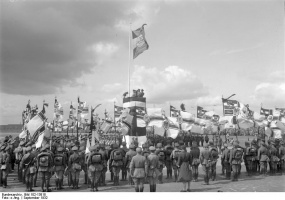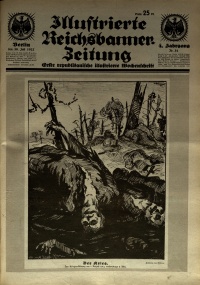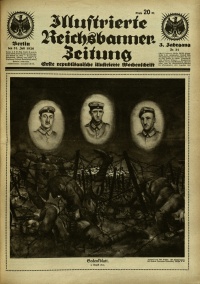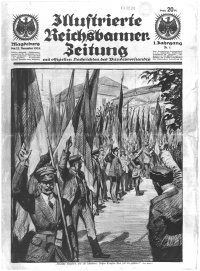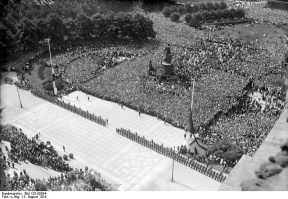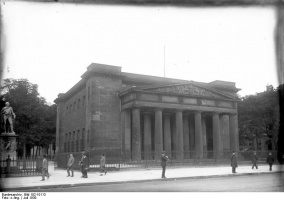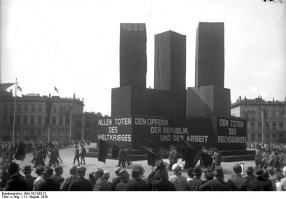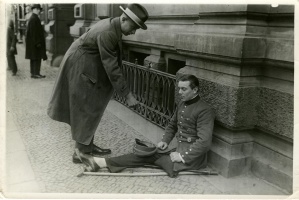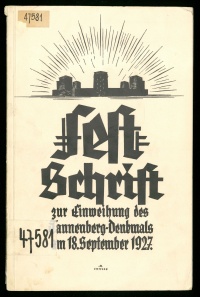Introduction↑
It is difficult to overstate the legacy of the First World War and its impact on post-1918 German society. Among forms of commemoration, the erection of monuments and the activities of war veterans’ organizations were not the only ways of remembering the dead but were some of the most visible ones. Often politicized, war commemoration rarely created unified mourning in Weimar Germany. The memories of the First World War were used to mobilize the public and did not remain confined to the past. However, the suggestion that by encapsulating nationalist feelings, heroic mythology, and sentiments of revenge German war memorials paved the way for their abuse by the National Socialists, has come under attack.[1] Research into commemorative practices in other countries suggests more differentiated continuities and differences,[2] and indeed within Germany war commemorations were not uniform. Veterans’ associations, by no means confined to the political right, offered space for their members’ war memories. Drawing different conclusions from the war, some fiercely argued for while others argued against Weimar democracy. This should not surprise us. Already in the late 1970s, historian Reinhart Koselleck drew attention to the important role of war memorials for the identity formation of post-war societies.[3] Members of veterans’ associations were no exception in this process. Within these contested memory battles relating to the "correct" interpretation of the war as well as the "correct" consequences to be drawn from it, Germany’s four biggest war veterans’ organizations agreed on a location for a national monument for the war dead in the mid-1920s – namely, Bad Berka, close to Weimar. This agreement, however, remained an exception. It did not influence politically divided commemorative activities of local associations.[4]
Monuments served various purposes; they were personal places to mourn, officially demonstrating that a local community had not forgotten its dead; on a wider scale they showed how a nation dealt with its losses. Monuments were for the living and attempted to create meaning(s) from past events.[5] An unveiling ceremony with speeches delivered by local officials might have created a completely different (temporary) framework for a monument than its successive use by those mourning. Before we turn to local monuments and commemorative activities carried out by veterans’ associations, we will first examine the thorny issue of a national monument dedicated to the German war dead.
The National Monument for the War Dead (Reichsehrenmal)↑
The idea of a national monument had already been discussed during the First World War and re-surfaced after 1918. Solved in England and France with national monuments for the Unknown Soldier in London and Unknown Soldier Tomb in Paris, the case in Germany was complicated by a combination of regional interests and the wish to find a genuine "German" design and location.[6]
In August 1924, an official celebration commemorating the tenth anniversary of the outbreak of war was held in Berlin. With a main focus on those lost in the war, Reich President Friedrich Ebert (1871-1925) turned a national monument for the war dead into a government project.[7] Thus from 1924 onwards, the republic discussed the location, architectural design and iconography, as well as purpose of a future national monument. During the long decision-making process, Prussia presented the Neue Wache in Berlin as its commemorative site. Unveiled in June 1931, after rebuilding works by Heinrich von Tessenow (1876-1950), the Neue Wache was soon seen as a national monument.[8] Additionally, in 1931 the republic finally chose Bad Berka as the location for a national monument, but did not yet have a design. The project outlived the Weimar state. After burying Reich President Paul von Hindenburg (1847-1934) in Tannenberg, Adolf Hitler (1889-1945) officially turned this East Prussian monument into one for the nation’s war dead in 1935.[9] In addition to the Tannenberg monument, the Nazis continued to use the Neue Wache in Berlin as a place of commemoration.
It was not a lack of public interest that had turned this national project into a difficult one in post-1918 Germany. On the contrary, the Reich Ministry of the Interior was swamped with proposals of prospective locations.[10] The newspaper Die Welt am Abend commented ironically: “The East Prussians want it [the national monument] in East Prussia, the fans of Hitler in Bavaria, the people of the Rhineland at the Rhine and the inhabitants of Hicksville in Hicksville.”[11] Brochures, booklets and publications proposing different locations for the monument showed several similarities: history and tradition of the location were stressed and linked to the German nation; the heroism and sacrifices of the war dead were expressed; and the future monument was to illustrate the gratefulness of all Germans to the dead soldiers.[12] There were a number of factors that encouraged the strong interest in having the national monument in one’s area. Tourism and the enhancement of a region’s appeal played an important, but not always explicitly mentioned role in local bids.
However, not everyone favoured a national monument. Historian Meinhold Lurz divided the reactions to the idea as they were expressed in the German press into four categories: first, the rejection of any plans for a monument due to its cost combined with the demand that the money should instead be spent on war victims; second, the erection of memorials only in conjunction with homes for disabled war veterans; third, the suggestion to wait to erect a national monument; and fourth, the support of a national monument for the war dead but no agreement on its location.[13] If reactions to a national monument can be divided fairly neatly, the different groups falling into these four categories were less homogenous. Political division lines, which played such an essential role in the Weimar Republic, became blurred on this particular issue. Left-wing and some republican newspapers agreed in their rejection of a monument and wanted to see more money spent on war veterans, widows, and orphans. Organisations caring for injured war veterans and those taking care of military cemeteries outside Germany put forward the same idea.[14]
While critical voices questioning the importance of a national monument did not disappear, the focus slowly shifted to issues of design and location. At the end of 1925, Germany’s four biggest veterans’ associations, the republican Reichsbanner Schwarz-rot-gold, the Reichsbund jüdischer Frontsoldaten (Reich League of Jewish Front-Line Soldiers), and the nationalist associations Stahlhelm and Kyffhäuserbund agreed on a national monument in the form of a "heroes grove" [Ehrenhain] in the forest of Bad Berka close to the city of Weimar. Ehrenhaine were in natural settings, often forests, linked to the notion of unspoiled beauty, a sense of Heimat and "sacred territory" for the country’s heroes. According to those who supported this idea, this combination could not be found in the big city.[15] It is worth keeping in mind that the national monuments for the Unknown Soldier in Paris and London presented a stark contrast to the German idea. Politically divided on most other issues, the representatives of the four veterans’ associations argued that they were speaking on behalf of more than 8 million Germans when they supported a "hero’s grove" in Bad Berka.[16] Angered by the fact that public discussions regarding the monument’s location continued despite their agreement, the representatives of the veterans’ associations made clear that a choice against their wishes undermined the project’s validity.[17] Eventually, in August 1931, a competition invited every German to submit a design for a national monument in Bad Berka. Almost 2,000 suggestions were made and publicly displayed in a Berlin exhibition in the summer of 1932.[18] Although the location had been chosen, every German was to have the opportunity to submit a design for the nation’s war dead monument. However, results of the competition came too late to be implemented. In the process of re-drafting and re-thinking some of the most promising designs from the 1932-competition, Adolf Hitler had risen to power in Germany in 1933. With no intention of seeing through a project that had occupied the Weimar Republic since August 1924, Hitler created his own commemorative site by turning the Tannenberg monument into Germany’s memorial for the war dead.
Local Monuments: Sites of Mourning↑
Criticizing the fuss made about a national monument, the Communist newspaper Die Welt am Montag pointed out that almost all local communities and villages already had a monument for the war dead.[19] In fact, most communities had more than one.[20] The mayor of the city of Bottrop wrote that his city had five locations to remember the war dead, including a monument on the cemetery, a plaque for its fallen civil servants in the city hall, a commemorative stone on the sports ground for dead members of the sports clubs, a remembrance chapel for the war dead and an honorary plaque for the pupils killed in the war.[21] As these ways of commemorating were common, the left-wing journal Die Weltbühne wrote in 1929: “War monuments are always part of the consequences of wars- even of lost ones …No town, no community can go without a heap of stones dedicated to ‘eternal rest and in memory of the dead’. Aren’t there enough mass graves and war cemeteries in Belgium and France?”[22]
But what Die Weltbühne formulated as criticism was exactly the point of many local monuments. Cherishing the memory of dead soldiers, these places were important precisely because the body of the beloved son, husband, father, brother or friend could not be brought home from mass graves or war cemeteries outside Germany. Local monuments in cemeteries, churches, market squares, city halls, schools, universities and sports grounds served as replacements for missing graves. Frequently, they were integrated into personal (sometimes daily) acts of grieving.[23] Together with local representatives of the city or village, veterans’ associations often initiated the set-up of a local monument and, if the monument was to be on church grounds, the local priest also became involved. Finances generally came from local authorities aided by door-to-door collections and other fund-raising events. Particularly in rural areas, monuments were decided on and erected without major conflict. In cities, where political divisions could often be played out more fully, the process did not always go so smoothly.[24]
In fact, a monument in Berlin-Kreuzberg illustrates this point. In the summer of 1928 the borough mayor Dr Herz urged the Prussian Ministry of the Interior and the Reich Ministry of Defence to withdraw building permission for a monument to be erected by the Officers’ Association of Former Guards Pioneers. The monument was to be a statue of an army pioneer. Herz pointed out that the local Social Democrats, the Communists and the members of the Democratic Party were against the monument. Furthermore, he claimed that the population was also against the monument. According to the mayor of Berlin-Kreuzberg, it sent the wrong message: “The planned monument is an army pioneer with complete war equipment. The public, especially the republican, will get the impression that the monument should not only serve respectful commemoration of fallen comrades, but that it is intended to represent militaristic striving for power…”[25] While the authorities refused to take action and pointed out that similar monuments had been erected elsewhere, the local mayor received support from other veterans’ organisations, which argued that the money could be put to better use.[26]
Not all monuments looked the same and, indeed, there were often alternatives to statues. Financial means as well as the location of monuments influenced their designs. Religious motifs were often chosen when the local priest was involved and when the monument was on church grounds. Memorial plaques followed by stone Findlinge (boulders) were the most affordable solution for many smaller communities. Occasionally, the local monument of one village or town was designed to be larger and more impressive than the one in the neighbouring area.[27] Unlike French war memorials, in which women and children were often part of the iconography showing the soldier-citizen returning home, German monuments and memorials retained the notion of the soldier as warrior, setting him apart from the civilian population.[28] Germany saw a wave of new war monuments from the end of the war until the hyperinflation in 1922-23. The late 1920s brought a completion of some of the projects that had been halted by the inflation. In 1921, Prussia’s Minister for Culture cautioned that the wish of many communities to quickly erect monuments and memorials could make them susceptible to tasteless Kitsch. He stressed that only careful planning would lead to dignified war commemorations.[29]
Rarely did monuments offer a pacifist message. An exception was the monument in Anweiler (in the Palatine), which not only commemorated the war dead, but also demanded “never again.” It stirred criticism and debate among citizens and visitors.[30] Naturally, not only pacifist monuments but also nationalist inscriptions caused debates. A monument in the city of Jüterbog with the Latin words “you unknown avenger shall rise from our mortal remains” triggered protest in republican newspapers.[31] But it was public commemorations of veterans’ associations that were the cause for most debates, especially when these organisations pitched their activities against each other.
Veterans’ Associations and their Activities: Divided Commemoration↑
Veterans’ associations offered space for the war memories of their members through social activities; they put forward interpretations of the war’s legacy and tried to secure financial support for their members. But the end of the war brought difficult years for many veterans’ associations, as membership numbers dwindled and competitor organizations were set up. Some organizations focused exclusively on the injured.[32] While the Kyffhäuserbund, the umbrella organization of a number of German veterans’ organizations, tried to modernize its image in the 1920s, most of its members continued to remain largely interested in social activities. These included the consecration of flags, the remembrance of the war dead, and initiatives to set-up local monuments.
But commemorative activities of veterans’ associations did not only mean trips down memory lane. The nationalist veterans’ association Stahlhelm (Steel Helmet-League of Front Soldiers), founded in December 1918, made no effort to disguise its anti-republican attitude. Loudly attacking the Weimar Republic, which in the eyes of the Stahlhelm was a betrayal of all those who had fought in the First World War, the nationalist veterans’ association combined commemorative activities with a clear political message against republican democracy. At its peak in 1932, the Stahlhelm had approximately 350,000 members.[33] While its commemorative activities did not differ from other veterans’ associations, the clear political statements against the new Weimar state brought the Stahlhelm into direct confrontation with republican veteran organizations.
For a long time, historians of Weimar Germany have primarily focused on right-wing war veterans’ associations, neglecting republican ones. Founded in 1924, in response to the extreme political threats to the Weimar Republic, the Reichsbanner Schwarz-rot-gold was open to all male republicans and stressed its role as a republican war veterans’ association supporting republican democracy. With approximately 1.5 million members, the republican organization was the biggest veteran association in Weimar Germany. The Reichsbanner wanted to give room to the war memories of its mostly working-class members and made clear that nationalist organizations should not monopolize commemoration activities.[34] Its journal commented: “…right-wing circles like to stress that the war dead are their dead…but the 2 million who died (with their different opinions and convictions) belong to the entire nation…”[35] Through its rhetoric, the Reichsbanner emphasized both the republican war dead and the idea that the republican state was the only positive outcome of the war. Title pages of the Reichsbanner’s journal depicted the brutality of the war, while its articles stressed that the horror and suffering of the war had at least lead to the Weimar constitution. The democratic constitution, according to the Reichsbanner, finally allowed the German people a say in the issue of war and peace.[36]
Local communities could view war commemorative activities organized by the republican Reichsbanner on one weekend, followed by the nationalist Stahlhelm the next one. The two organizations’ festive choreography hardly differed, except for the flags representing each group -- either the republican colours black-red-gold (Reichsbanner) or the imperial ones black-white-red (Stahlhelm). Furthermore, the interpretative framework of the war and the conclusions drawn from it for the country’s political direction differed substantially.
Ceremonies to honor the war dead or to unveil a monument in their memory could cause debates, due to both the flags present at the events and the people attending. Republicans wrote angry letters to local authorities when members of the army attended festive ceremonies flying the imperial flag (instead of the colours of the republic) and dwelling on the memories of Imperial Germany.[37] Often linked to the annual religious cycle, German society had different dates throughout the year to commemorate its war dead. Commemorations took place in early November (All Souls) and in early March, when the private organization Volksbund deutscher Kriegsgräberfürsorge (National League for the Maintenance of German War Memorials) commemorated the dead.[38] The March date caused tensions. In 1925 it coincided with the funeral of Reich President Friedrich Ebert and while nationalist veterans’ organizations commemorated the war dead with black-white-red flags, republicans felt that the late Reich President was being insulted with this display of anti-republican colors. Similar problems again occurred a year later.[39] In March 1930, republicans commemorated the overthrow of the right-wing Kapp purge that had occurred ten years earlier. Nationalist right-wing newspapers wrote angrily that the republicans were degrading the war dead on a date when they should be commemorated.[40]
Conclusion↑
Commemorating the war dead meant different things for different people in post-1918 Germany, and it also differed for men and women. For some, the local monument was a place to express individual grief for lost ones, while for others it was part of public ceremonies at which veterans’ associations advocated their interpretation(s) of the war’s legacy under imperial or republican flags. First World War commemorations created neither unified mourning nor a consensus regarding the country’s past or its political future. While the largely enthusiastic response to a national monument for the war dead (Reichsehrenmal) showed that the republican state had struck the right chord in promoting the project, the fierce debates about its location and design illustrated strong regional clashes. The extraordinary agreement between politically divided veterans’ associations regarding the national monument did not extend to other areas of commemorative practices or political mobilization. Veterans’ associations in other countries were much more successful at joining together and creating a unified voice. When the republican war veterans’ association Reichsbanner Schwarz-rot-gold and its right-wing nationalist counterpart Stahlhelm occupied public space, for example by marching through the local town centre, the two organizations communicated not only their opposing interpretations of the war’s legacy, but also their diverging ideas about the political present and future of Germany. Republican war commemoration played an important part in these contested memory battles and the republicans did not leave the cult of the dead to the conservative or nationalist forces. Unlike in France or Britain, First World War commemoration in Germany rarely created moments of national consensus.
Nadine Rossol, University of Essex
Section Editor: Christoph Cornelißen
Notes
- ↑ I would like to thank Benjamin Ziemann for his very helpful comments on an earlier draft of this article. See Mosse, George L.: Fallen Soldiers. Reshaping the Memory of the World Wars, Oxford 1990.
- ↑ Koselleck, Reinhart/Jeismann, Michael (eds.): Der politische Totenkult. Kriegerdenkmäler in der Moderne, Munich 1994. For a comparison between Germany and the UK see Goebel, Stefan: The Great War and Medieval Memory, Cambridge 2007.
- ↑ Koselleck, Reinhart: Kriegerdenkmale als Identitätsstiftung der Überlebenden, in: Marquard, Odo/Stierle, Karlheinz (eds.): Identität, Munich 1979, pp. 255-276. The article is published in English in: Koselleck, Reinhart: War Memorials as Identity Formation of Survivors, in Koselleck, Reinhart (ed.): The Practice of Conceptual History, Stanford 2002.
- ↑ See Saehrendt, Christian: Der Stellungskrieg der Denkmäler. Kriegerdenkmäler im Berlin der Zwischenkriegszeit 1919-39, Bonn 2004.
- ↑ See Winter, Jay: Sites of Memory, Sites of Mourning. The Great War in European Cultural History, Cambridge 1995.
- ↑ See Ziemann, Benjamin: Die deutsche Nation und ihr zentraler Erinnerungsort, in: Berding, Helmut, et al (eds.): Krieg und Erinnerung, Göttingen 2000, pp. 67-91. A grave for the Unknown Soldier was debated as an option for Germany but never materialised. See the extraordinary idea of Edwin Redslob in: Das Soldatengrab im Rhein, in: Berliner Tageblatt, 302, 28.6.1925.
- ↑ Behrenbeck, Sabine: The Nation Honours the Dead. Remembrance Days for the Fallen in the Weimar Republic and the Third Reich, in: Friedrich, Karin (ed.): Festive Culture in Germany and Europe from the 16th Century to the 20th Century, Lewiston 2000, pp. 306-312.
- ↑ Forner, Sean A.: War Commemoration and the Republic in Crisis. Weimar Germany and the Neue Wache, in: Central European History, 25 (2002), pp. 513-549; Stoffels, Michaela: Kriegerdenkmale als Kulturobjekte, Cologne 2011, pp. 225-241.
- ↑ See Fischer, Heike: Tannenberg-Denkmal und Hindenburgkult, in: Hütt, Michael, et al (eds.): Unglücklich das Land, das Helden nötig hat. Leiden und Sterben in den Kriegsdenkmälern des ersten und zweiten Weltkrieges, Marburg 1990, pp. 29-39.
- ↑ Bundesarchiv Berlin (hereafter BArch Berlin), R1501/11621 (no page number) Sept. 1925; BArch Berlin, R601/723, pp. 84-94, Nov. 1925; BArch Berlin, R601/723, pp.153-159, Feb. 1926; BArch Berlin, R32/353a, pp.81-93, Oct. 1926.
- ↑ Reichs-Ehrenhetzmal, in: Die Welt am Abend, 3.12.1927.
- ↑ BArch Berlin, R601/723, p.74ff, Frauenberg, Denkschrift zur Lösung der Platzfrage für das Reichsehrenmal; BArch Berlin, R601/724, Das Reichsehrenmal auf der Insel Hammerstein im Rhein, 1926; BArch Berlin, R601/725, H. Jacobi, Vorschlag zu einem Reichsehrenmal am Rhein auf dem Ehrenbreitstein.
- ↑ Lurz, Meinhold: Kriegerdenkmäler in Deutschland. Weimarer Republik, vol. 4, Heidelberg 1985, pp. 50-51.
- ↑ Letters by veterans’ associations can be found in BArch Berlin, R1501/11621.
- ↑ Ziemann, Benjamin: Contested Commemorations. Republican War Veterans and Weimar Political Culture, Cambridge 2013, pp.173-175.
- ↑ BArch Berlin, R32/355, pp. 14-17.
- ↑ Public letter printed in Das Reichsbanner, 17, 1.9.1926, Reichsehrenmal. See also Ulrich, Bernd/Ziemann, Benjamin (eds.): Krieg im Frieden, Frankfurt am Main 1997, pp. 137-138.
- ↑ Redslob, E.: Wettbewerb Reichsehrenmal, in: Die Bauzeitung, 20, 15.7.1932.
- ↑ Reichs-Protzmal, in: Die Welt am Montag, 17, 28.4.1930.
- ↑ BArch Berlin, R32/351, p. 11 the city of Rathenow possessed five commemorating stones for killed soldiers; BArch Berlin, R32/352, p.8 the city of Schmölln (Thuringia) listed six locations: three plaques and three commemorative stones.
- ↑ BArch Berlin, R32/347, Letter: Mayor of Bottrop to E. Redslob, 3.8.1927.
- ↑ Denkmäler überall, in: Die Weltbühne, 14, 2.4.1929, p. 536.
- ↑ Ziemann, Benjamin: War Experiences in Rural Germany 1914-1923, Oxford 2007, pp. 266-268.
- ↑ Ibid, pp. 254-255.
- ↑ Geheimes Staatsarchiv Preußischer Kulturbesitz, I HA Rep. 77 Tit. 1215, drittes Beiheft 1, letter: Herz to Reich Minister of Defence, 4.7.1928 (no page numbers).
- ↑ Ibid, responses to Dr Herz 16.7.1927 and 28.7.1928.
- ↑ Ziemann, War Experiences in Rural Germany 2007, pp. 255-256.
- ↑ Jeismann, Michael/Westheider, Rolf: Wofür stirbt der Bürger? Nationaler Totenkult und Staatsbürgertum in Deutschland und Frankreich seit der Französischen Revolution, in: Koselleck/Jeismann (eds.), Der politische Totenkult 1994, pp. 23-50.
- ↑ Ulrich/Ziemann (eds.), Krieg im Frieden 1997, p. 126.
- ↑ Ibid, p.130. For two other monuments with pacifist messages see Behrenbeck, Sabine: Zwischen Trauern und Heroisierung. Vom Umgang mit Kriegstod und Niederlage nach 1918, in Duppler, Jörg/Groß, Gerhard P. (eds.): Kriegsende 1918, Munich 1999, p. 319.
- ↑ Denkmäler, in: Deutsche Republik, 35, 1.6.1928.
- ↑ Ziemann, War Experiences in Rural Germany 2007, p. 245; Ulrich/Ziemann (eds.), Krieg im Frieden 1997, p. 177.
- ↑ Ziemann, Contested Commemorations 2013, p. 15, table 1. See also Fritzsche, Peter: Rehearsals for Fascism. Populism and Political Mobilisation in Weimar Germany, Oxford 1990; Berghahn, Volker Rolf: Der Stahlhelm. Bund der Frontsoldaten 1918-1935, Düsseldorf 1966.
- ↑ See Ziemann, Contested Commemorations 2013.
- ↑ Die Toten Deutschlands, in: Das Reichsbanner, 47, 23.11.1929.
- ↑ Die Ehrenpflicht gegen unsere Gefallenen, in: Illustrierte Reichsbanner Zeitung (IRZ), 6, 7.2.1925; IRZ, 32, 7.8.1926, Verfassungstag. See also Rossol, Nadine: Weltkrieg und Verfassung als Gründungserzählungen der Republik, in: APuZ, 50-51, Dec. 2008, pp. 15-18.
- ↑ BArch Berlin, R8034III/7692, 11.10.1926.
- ↑ Petersen, Thomas Peter: Der Volkstrauertag, Bad Kleinen 1998, pp. 9-17.
- ↑ Trauer und Terror, in: Der Tag, 54, 4.3.1925; Trauerfeier der Republik, in: Vorwärts, 106, 4.3.1925; Der missbrauchte Volkstrauertag, in: Kreuz Zeitung, 101, 2.3.1926; Heldenschändung? in: Berliner Tageblatt, 102, 2.3.1926,.
- ↑ Klassenkampf am Volkstrauertag, in: Berliner Börsen Zeitung, 101, 1.3.1930; Reichsbanner plant Entweihung des Volkstrauertages, in: Der Tag, 51, 28.2.1930.
Selected Bibliography
- Behrenbeck, Sabine: The nation honours the dead. Remembrance days for the fallen in the Weimar Republic and the Third Reich, in: Friedrich, Karin (ed.): Festive culture in Germany and Europe from the sixteenth to the twentieth century, Lewiston 2000: Edwin Mellen Press, pp. 303-322.
- Forner, Sean A.: War commemoration and the Republic in crisis. Weimar Germany and the Neue Wache, in: Central European History 35/4, 2002, pp. 513-549.
- Fritzsche, Peter: Rehearsals for fascism. Populism and political mobilization in Weimar Germany, New York 1990: Oxford University Press.
- Koselleck, Reinhart: War memorials as identity formation of survivors, in: Koselleck, Reinhart / Presner, Todd Samuel (eds.): The practice of conceptual history. Timing history, spacing concepts, Stanford 2002: Stanford University Press.
- Koselleck, Reinhart, Jeismann, Michael (ed.): Der politische Totenkult. Kriegerdenkmäler in der Moderne, Munich 1994: Fink.
- Lurz, Meinhold: Kriegerdenkmäler in Deutschland. 4. Weimarer Republik, volume 4, Heidelberg 1985: Esprint-Verl..
- Rossol, Nadine: Weltkrieg und Verfassung als Gründungserzählungen der Republik, in: Aus Politik und Zeitgeschichte 50-51, 2008, pp. 13-18.
- Saehrendt, Christian: Der Stellungskrieg der Denkmäler. Kriegerdenkmäler im Berlin der Zwischenkriegszeit (1919-1939), Bonn 2004: Dietz.
- Stoffels, Michaela: Kriegerdenkmale als Kulturobjekte. Trauer- und Nationskonzepte in Monumenten der Weimarer Republik, Cologne 2011: Böhlau.
- Ulrich, Bernd / Ziemann, Benjamin (eds.): Krieg im Frieden. Die umkämpfte Erinnerung an den Ersten Weltkrieg. Quellen und Dokumente, Frankfurt a. M. 1997: Fischer.
- Winter, Jay: Sites of memory, sites of mourning. The Great War in European cultural history, Cambridge 2000: Cambridge University Press.
- Ziemann, Benjamin: War experiences in rural Germany, 1914-1923, Oxford; New York 2007: Berg.
- Ziemann, Benjamin: Contested commemorations. Republican war veterans and Weimar political culture, Cambridge; New York 2013: Cambridge University Press.
- Ziemann, Benjamin: Die deutsche Nation und ihr zentraler Erinnerungsort. Das Nationaldenkmal für die Gefallenen im Weltkrieg und die Idee des Unbekannten Soldaten 1914-1935, in: Berding, Helmut / Heller, Klaus / Speitkamp, Winfried (eds.): Krieg und Erinnerung. Fallstudien zum 19. und 20. Jahrhundert, Göttingen 2000: Vandenhoeck & Ruprecht, pp. 67-92.





